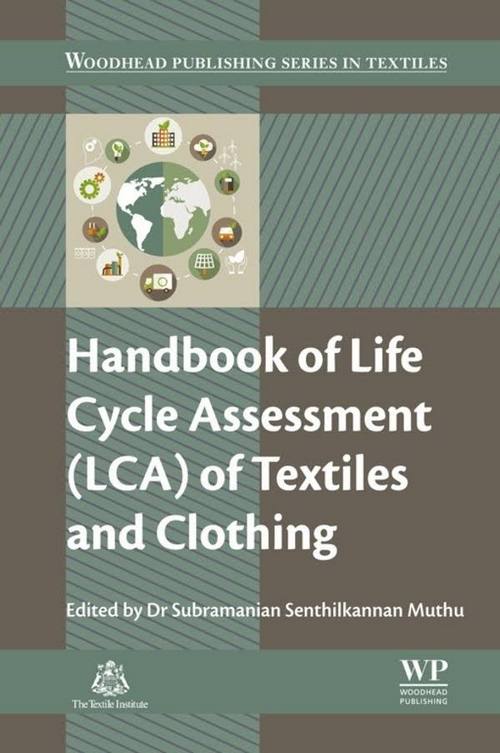
Table of Contents
The Textile Institute and Woodhead Publishing
List of contributors
Woodhead Publishing Series in Textiles
Introduction
Part One. Key indicators and processes in LCA
1. Carbon footprints in the textile industry
1.1. Introduction
1.2. Key issues in calculating carbon footprints
1.3. Carbon footprint standards
1.4. Calculating carbon footprints of textile manufacturing processes
1.5. Calculating carbon footprints of textile products
1.6. Carbon footprint labelling of textile products
1.7. Future trends
1.8. Conclusions
1.9. Further information and advice
2. Energy footprints in the textile industry
2.1. Introduction: key issues in calculating energy footprints
2.2. Methodologies and standards
2.3. Calculating energy footprints of textile products (applications and examples)
2.4. How to reduce energy footprint in textile and clothing products
2.5. How to reduce energy footprint in textile and clothing supply chain
2.6. Energy analysis in the textile industry
2.7. Energy analysis from the view of environmental approaches
2.8. Future trends
2.9. Conclusions
2.10. Additional readings about energy in the textile industry
3. Ecological footprints in the textile industry
3.1. Introduction
3.2. Methodologies and standards
3.3. Calculating ecological footprint of a textile manufacturing plant
3.4. Calculating ecological footprints of textile products: evaluation of footwear as case study
3.5. Future trends and challenges in calculating the EF of textile products
3.6. Conclusions
4. Measuring the reusability of textile products
4.1. Introduction
4.2. Importance of reusability in LCA
4.3. Implications of reusability in textiles and clothing products
4.4. Importance of reusability in LCA studies
4.5. Quantification of reusability of textiles and clothing products
4.6. Future trends and remarks
4.7. Conclusions
5. Environmental impacts of the use phase of the clothing life cycle
5.1. Introduction: the use phase in the life cycle of clothing
5.2. Quantifying the use phase of the clothing life cycle
5.3. Consumer use phase in LCA studies of textiles and clothing products – implications for LCA
5.4. Challenges and conclusions
6. Open- and closed-loop recycling of textile and apparel products
6.1. Introduction
6.2. Recycling textiles and apparel
6.3. Open-loop recycling
6.4. Closed-loop recycling
6.5. Barriers to effective OLR and CLR
6.6. Future trends in the apparel industry
6.7. Conclusion
List of abbreviations
7. Life cycle assessment method for environmental impact evaluation and certification systems for textiles and clothing
7.1. Introduction
7.2. Life cycle assessment and environmental impacts of textiles and clothing
7.3. Standards and associations for environmental management systems
7.4. Eco-labelling and certification of textiles and clothing
7.5. Conclusions
8. Environmental impact assessment methods for textiles and clothing
8.1. Introduction
8.2. Review of EIA process and methods
8.3. An EIA tool kit for the textile and clothing industry: the Sustain Tex system
8.4. Illustrative example
8.5. Conclusions and future trends
Part Two. Applications of LCA in the textile industry
9. Life cycle assessment of cotton textiles and clothing
9.1. Introduction
9.2. LCA of cotton textiles
9.3. LCA of technical cotton textiles
9.4. Discussion of LCA results
9.5. Factors influencing sustainability of cotton textiles
9.6. Conclusions
10. LCA of wool textiles and clothing
10.1. Introduction
10.2. Wool LCA methodological and data challenges
10.3. LCA case study for wool apparel
10.4. Summary and future developments in wool LCA studies
11. Life cycle assessment of silk production – a case study from India
11.1. Introduction
11.2. LCI of Indian silk
11.3. Results and discussion
11.4. Conclusions
12. Comparative life cycle assessment of natural and man-made textiles
12.1. Introduction
12.2. Natural and man-made textiles
12.3. LCA studies
12.4. Concluding remarks
13. LCA of cotton shopping bags
13.1. Introduction
13.2. Shopping bags and their environmental impacts
13.3. Cotton shopping bags
13.4. LCA studies on cotton shopping bags
13.5. Conclusions
14. LCA of fibre-reinforced composites
14.1. Introduction
14.2. Types of fibre-reinforced composites
14.3. LCA method and models
14.4. LCA of composites made out of different materials: examples and case studies
14.5. Conclusions
15. Life cycle assessment and the environmental and social labels in the textile and clothing industry
15.1. Environmental and social labels: definitions
15.2. Classifications of social and environmental labels
15.3. Life cycle assessment and greenwashing in textiles and clothing
15.4. A comparison of the selected environmental and social labels in terms of LCA
15.5. The utility of environmental and social labels for consumers – barriers and challenges
15.6. Future trends and concluding remarks
16. Clothing disposal habits and consequences for life cycle assessment (LCA)
16.1. Introduction
16.2. Methods
16.3. Results
16.4. Discussion
16.5. Conclusions
Index
